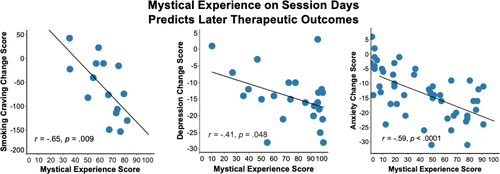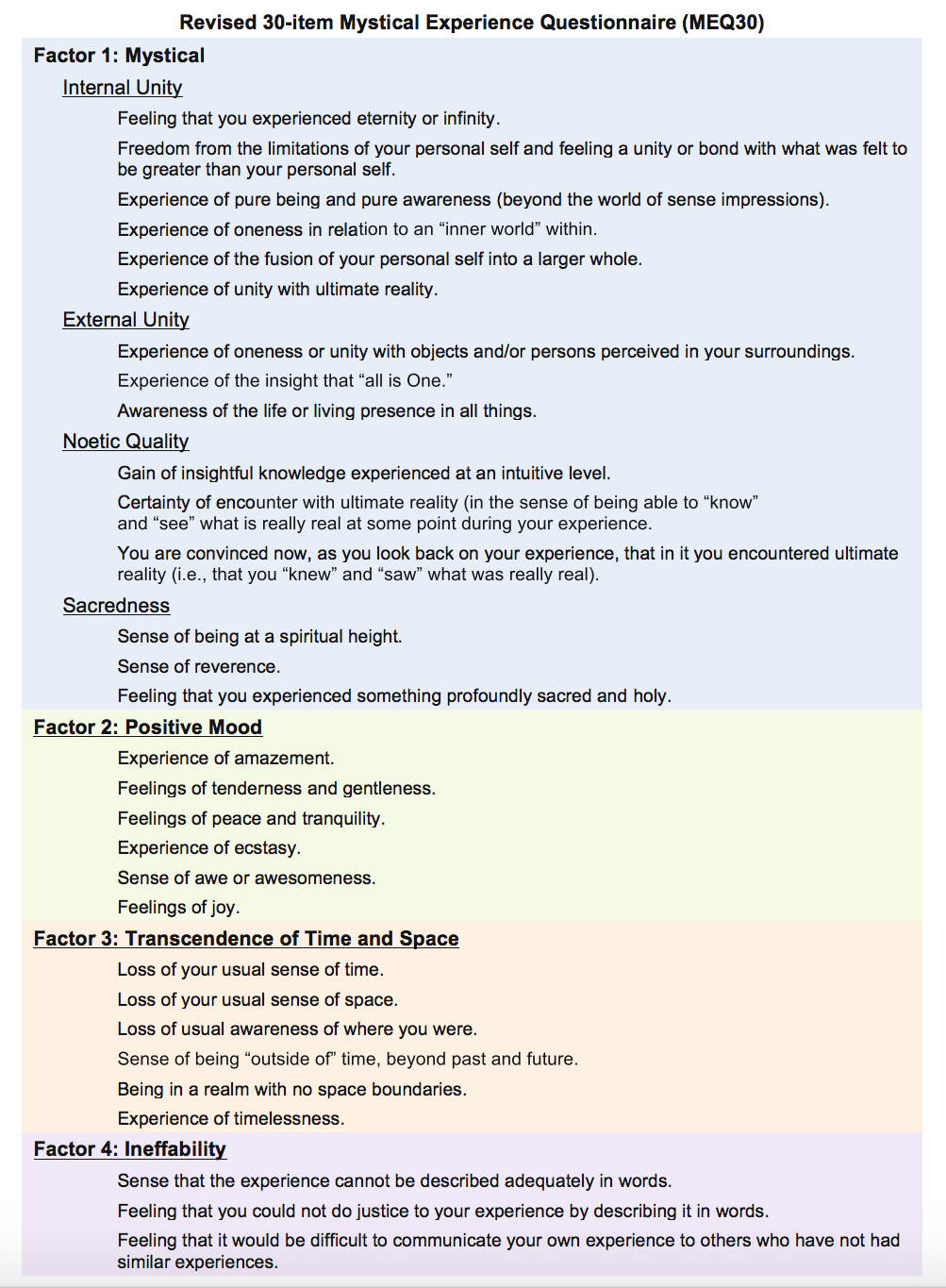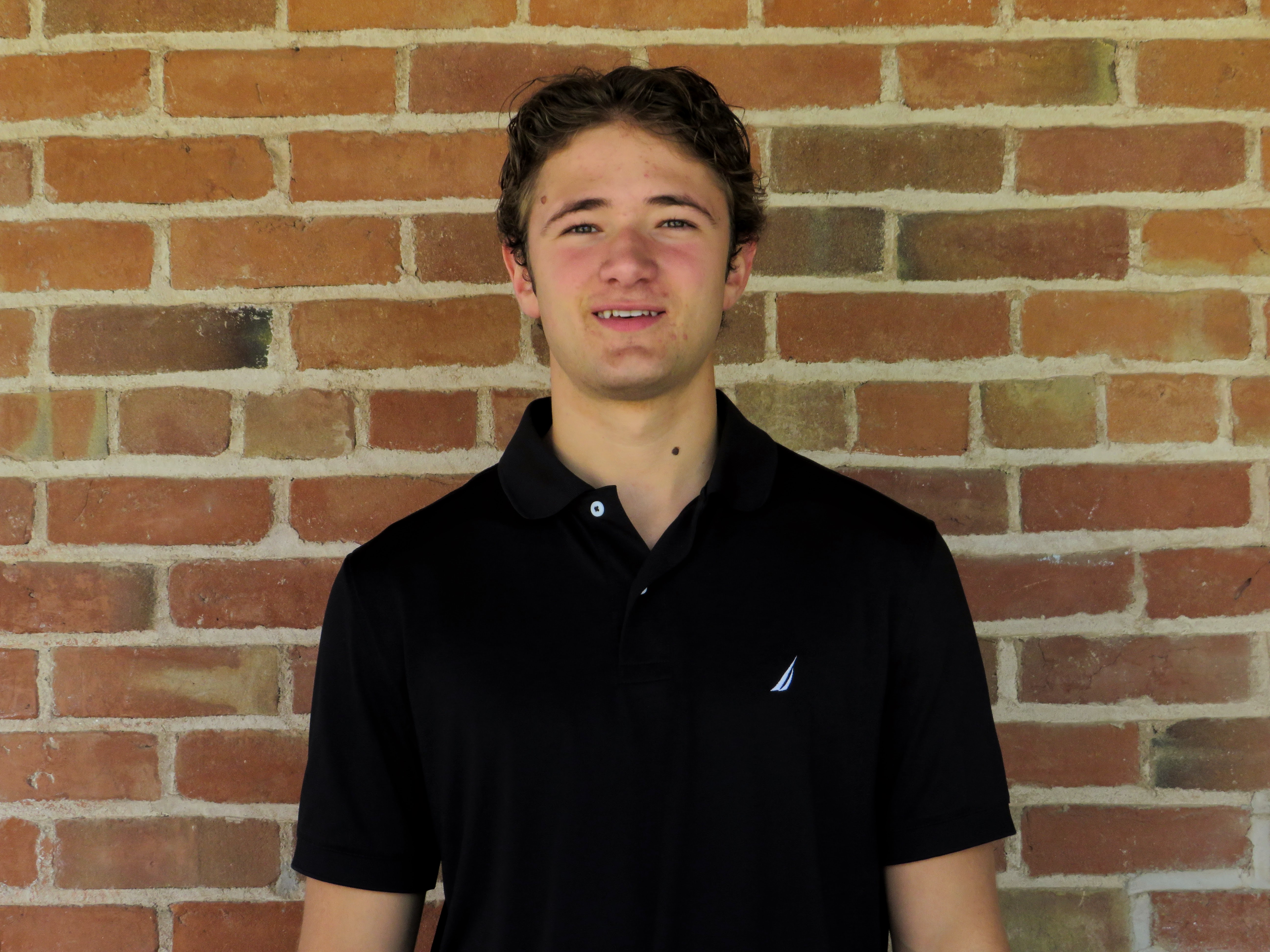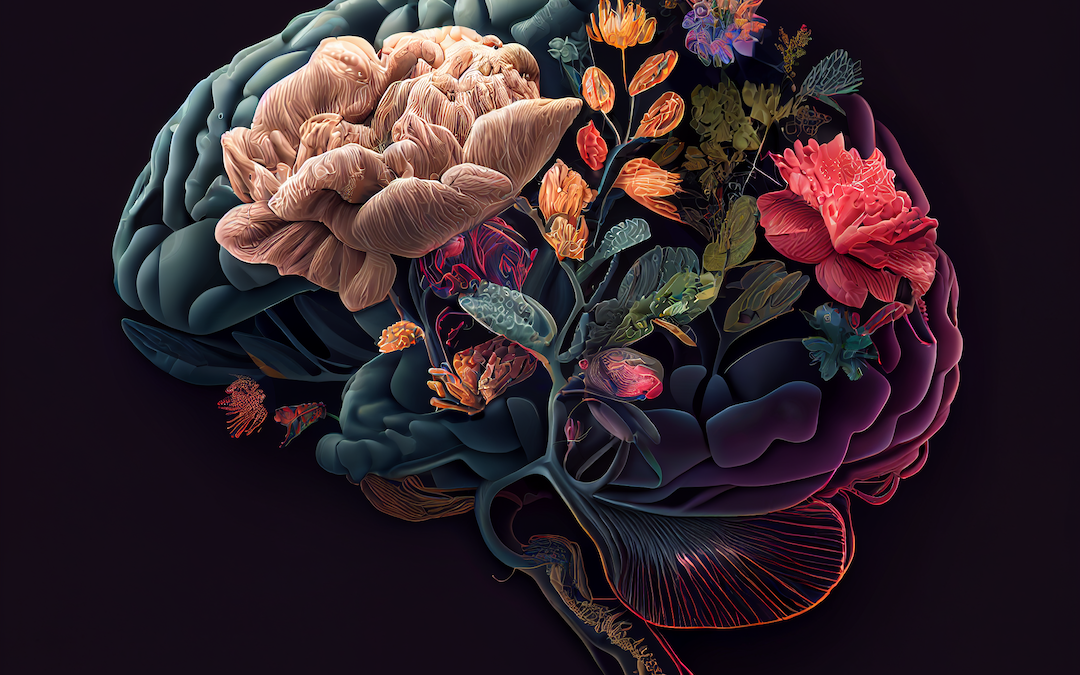We know psychedelics can be helpful, but do we need to trip to get the benefits? Psychedelics have recently gained lots of attention because of their potential therapeutic effects. This paper covers some of the ways psychedelics affect their consumers. It is important to point out that psychedelic ingestion in these studies occurs within a research setting. Often, there are two professionally trained psychologists as well as a medical team on hand during sessions. I am not endorsing the consumption or possession of illegal substances, but am committed to the scientific exploration of the therapeutic application of these compounds. Can We Heal Without Psychedelics? Psychedelics have recently gained lots of attention because of their potential therapeutic effects
So far, we have seen the promise of psychedelics in the treatment of mood, anxiety, and substance use disorders (1), but is the trip, or the conscious experience of an altered reality, necessary for these long-term therapeutic benefits? Or can our brain and outlook on life change the same way without a perceived experience? This question is illustrated in the figure below (2). It is conceivable that hallucinations are manifestations of psychedelic drug-induced changes in the structure of the brain. We know that psychedelics have the ability to promote structural and functional changes in the brain, and that antidepressant effects are associated with reorganization of brain pathways (3). Both of these seem like they could happen without hallucinating, but is this the case?

The above image was taken from The Subjective Effects of Psychedelics Are Necessary for Their Enduring Therapeutic Effects by David B. Yaden and Rolland Griffiths
The way that scientists currently measure the ‘strength’ of a trip is with something called the Mystical Experience Questionnaire (MEQ). It allows patients to report their experience in four categories. These are: One, an authoritative sense of unity or connectedness accompanied by feelings of reverence; two, positive feelings such as love or peace; three, alterations to the sense of both time and space; and four, difficulty with putting the experience into words (1). As you can see in the figure titled Mystical Experience on Session Days Predicts Later Therapeutic Outcomes (replotted from Garcia et al.) (2, 4), high ratings on this questionnaire are predictive of better outcomes.

We must remember, however, that correlation is not the same as causation. Still, the more mystical the trip was, the more likely there was an improvement. Additionally, in one psilocybin study, high scores on the MEQ during session days accurately predicted positive outcomes in attitudes about life, self, mood and behavior after 6 months (5). This is significant, especially compared to the rates of improvement involving common antidepressants. High scores were also predictive of substantial and enduring decreases of anxiety and depression in patients (6, 7) who had received a life-threatening cancer diagnosis. Many people even consider their psychedelic experience to be among the most profound and meaningful events in their lives, leading to lasting changes in their world view (8). So it seems like the stronger the trip is, the better the outcome is. This is supported by the fact that many patients who have received high doses of a psychedelic attribute mental healing to their subjective experience while under the drug’s influence. Psychedelics have recently gained lots of attention because of their potential therapeutic effects

This MEQ graphic comes from here: https://freedomandfulfilment.com/mystical-experience-psychedelics/
Does this mean that the trip is necessary for improvement? It seems like it may be, but we cant be sure yet. There’s still variation in the data. It could be that patients who are more likely to improve are more also more likely to have mystical experiences. As I’ve said above, correlation is not the same as causation. Since psychedelics seem to be effective at promoting the growth of cortical pyramidal neurons (12), they are well suited to treat diseases that are known to be a result (or a cause) of broken down neurons and their communications among each other, such as anxiety disorder, depression, schizophrenia, and PTSD (10, 11). Paradoxically, psychedelics, specifically negative experiences on psychedelics, can cause some of these conditions as well. This is one reason why it would be beneficial to have trip-less psychedelics. Can we change these circuits without inducing psychedelic subjective effects? For some people, the consumption of psychedelics can be dangerous because they have a psychotic disorder that makes them vulnerable to a psychotic episode. At any given time, around 3% of the human population suffers from a psychotic disorder (9). It seems like taking psychedelics can rearrange thought patterns in a way that takes the weight off of their shoulders, which is certainly remarkable, but we still do not know if the subjective experience is necessary for a therapeutic effect. “The trip” may just be the conscious experience of brain changes that can happen without an ‘observer.’ At the University of Wisconsin, Madison, a study that may provide an answer to some of these questions is underway. The title of the study is ‘Recall of Experience and Conscious Awareness in Psilocybin Treatment of Depression’ (RECAP). This study aims to induce a state of amnesia during a psilocybin experience using Midazolam. This study may provide insight into whether or not the development of “tripless psychedelics” is worthwhile or at the very least give an idea of what kind of outcomes future clinical trials with these novel drugs may look like.
With time, only more research will tell how closely linked the neurophysiological effects (that are collected) and the measurable psychological effects of psychedelics are in relation to their therapeutic effects. It’s possible that there are brain changes reflecting the mystical experience-dimension of psychedelics that are not getting captured by current quantitative approaches. These outcomes may not be readily or easily parsable between effects from psychedelics versus those in mimicking “non-psychedelic” analogs.
While there is evidence to suggest that the subjective experience of an altered state of consciousness is correlated with therapeutic outcomes, it is not yet clear whether this experience is necessary for long-term benefits. With ongoing research and the development of “tripless psychedelics,” we may soon have a better understanding of how important a psychedelic experience is for various applications of psychedelic-inspired pharmacology.
Full Citations:
- Nautiyal, K. M., & Yaden, D. B. (2022). Does the trip matter? Investigating the role of the subjective effects of psychedelics in persisting therapeutic effects. Neuropsychopharmacology, https://doi.org/10.1038/s41386-022-01424-z.
- Yaden, D. B., & Griffiths, R. R. (2021). The Subjective Effects of Psychedelics Are Necessary for Their Enduring Therapeutic Effects. ACS Pharmacology & Translational Science, 4(2), 568-572. https://doi.org/10.1021/acsptsci.0c00194.
- Ly, C., Greb, A. C., Cameron, L. P., Wong, J. M., Barragan, E. V., Wilson, P. C., … & Olson, D. E. (2018). Psychedelics Promote Structural and Functional Neural Plasticity. Cell Reports, 23(11), 3170-3182. https://doi.org/10.1016/j.celrep.2018.05.022.
- Garcia-Romeu, A., Griffiths, R., & Johnson, M. (2015). Psilocybin-occasioned mystical experiences in the treatment of tobacco addiction. Current Drug Abuse Reviews, 7(3), 157-164. https://doi.org/10.2174/1874473708666150107121331.
- Griffiths, R. R., Johnson, M. W., Richards, W. A., Richards, B. D., Jesse, R., MacLean, K. A., … & Klinedinst, M. A. (2018). Psilocybin-occasioned mystical-type experience in combination with meditation and other spiritual practices produces enduring positive changes in psychological functioning and in trait measures of prosocial attitudes and behaviors. Journal of Psychopharmacology, 32(1), 49-69. https://doi.org/10.1177/0269881117731279.
- Griffiths, R. R., Johnson, M. W., Carducci, M. A., Umbricht, A., Richards, W. A., Richards, B. D., … & Klinedinst, M. A. (2016). Psilocybin produces substantial and sustained decreases in depression and anxiety in patients with life-threatening cancer: A randomized double-blind trial. Journal of Psychopharmacology, 30(12), 1181-1197. https://doi.org/10.1177/0269881116675513
- Ross, S., Bossis, A., Guss, J., Agin-Liebes, G., Malone, T., Cohen, B., … & Schmidt, B. L. (2016). Rapid and sustained symptom reduction following psilocybin treatment for anxiety and depression in patients with life-threatening cancer: a randomized controlled trial. Journal of Psychopharmacology, 30(12), 1165-1180. https://doi.org/10.1177/0269881116675512.
- ACS Pharmacology & Translational Science (2021, 4, 2, 563-567). https://doi.org/10.1021/acsptsci.0c00192.
- “The Long-Term Outcomes of Antipsychotic Polypharmacy in Schizophrenia.” JAMA Psychiatry, vol. 70, no. 4, Apr. 2013, pp. 392-399. JAMA Network, jamanetwork.com/journals/jamapsychiatry/article-abstract/209973.
- Zhang, X., T. Ge, G. Yin, R. Cui, G. Zhao, and W. Yang. “Stress-Induced Functional Alterations in Amygdala: Implications for Neuropsychiatric Diseases.” Frontiers in Neuroscience, vol. 12, 2018, p. 367. doi:10.3389/fnins.2018.00367.
- Yin, X., N. Guven, and N. Dietis. “Stress-Based Animal Models of Depression: Do We Actually Know What We Are Doing?” Brain Research, vol. 1652, 2016, pp. 30-42. doi:10.1016/j.brainres.2016.09.027Ly, C., A. C. Greb, M. V. Vargas, W. C. Duim, A. C. Grodzki, P. J. Lein, and D. E. Olson. “Transient Stimulation with Psychoplastogens Is Sufficient to Initiate Neuronal Growth.” ACS Pharmacology & Translational Science, vol. 4, no. 2, 2020, pp. 452-460. doi:10.1021/acsptsci.0c00065.
- Ly, C., A. C. Greb, M. V. Vargas, W. C. Duim, A. C. Grodzki, P. J. Lein, and D. E. Olson. “Transient Stimulation with Psychoplastogens Is Sufficient to Initiate Neuronal Growth.” ACS Pharmacology & Translational Science, vol. 4, no. 2, 2020, pp. 452-460. doi:10.1021/acsptsci.0c00065.
About The Author

Evan Laughlin
More IPN Blogs
Bridging the Gap Between the Past and Present in the Psychedelic Renaissance
Cover art created using OpenAI's DALL-E image generator* “It was my destiny to join a great experience”- This quote by Herman Hesse welcomed attendees to the 2023 biannual Psychedelic Science Conference hosted by MAPS in Denver, Colorado. Like hundreds of others in...
Integrating Psychedelics and Paralysis: Understanding Non-Obvious Risks Before Pursuing Likely Rewards
Cover art created using OpenAI's DALL-E image generator* A setting sun paints the San Diegan marine clouds a pastel palette as onlookers atop a coastal bluff wait for the famous green flash. Down below on the beach two gentlemen anticipate a different flash. Both have...
Honoring the Legacy of Dr. Roland Griffiths: Exploring the Mystical World of Psilocybin
Image Source: The Chronicle of Higher Education The world lost a true pioneer and visionary when Dr. Roland Griffiths, a renowned figure in the field of psychopharmacology, passed away from cancer. Dr. Griffiths dedicated his life to studying the profound effects of...
